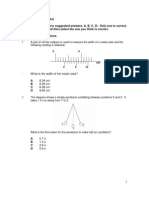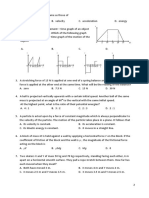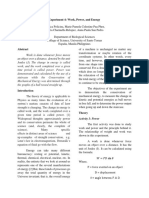Physics MSCQ
Physics MSCQ
Uploaded by
keshav GopaulCopyright:
Available Formats
Physics MSCQ
Physics MSCQ
Uploaded by
keshav GopaulOriginal Title
Copyright
Available Formats
Share this document
Did you find this document useful?
Is this content inappropriate?
Copyright:
Available Formats
Physics MSCQ
Physics MSCQ
Uploaded by
keshav GopaulCopyright:
Available Formats
2
1 A list of various quantities is shown.
acceleration
displacement
force
length
mass
velocity
How many of these quantities are vectors?
A 2 B 3 C 4 D 5
2 A student determines the circumference of a football.
Which instrument gives a reading that is the circumference of the football?
A calipers
B micrometer
C rule
D tape
3 A train sets off from a station at time t = 0. The graph shows how the distance between the train
and the station varies with time.
distance
0
0 t1 t2 time t
Which statement about the movement of the train between time t1 and t2 is correct?
A Its speed is decreasing and it is moving away from the station.
B Its speed is decreasing and it is moving towards the station.
C Its speed is increasing and it is moving away from the station.
D Its speed is increasing and it is moving towards the station.
© UCLES 2021 5054/11/M/J/21
3
4 A coin falls from rest through the air and eventually reaches a constant speed.
There is a resultant force acting on the coin due to the two forces P and Q shown in the diagram.
What happens to force P and what happens to the resultant force before the coin reaches
constant speed?
force P resultant force
A decreases increases
B decreases decreases
C increases decreases
D increases increases
5 A satellite is shown moving around the Earth in a circular path at a constant speed.
Which arrow shows the direction of the force on the satellite?
A B
direction of satellite
motion
not to scale
D C
Earth
© UCLES 2021 5054/11/M/J/21 [Turn over
4
6 Which row shows the mass and the weight of an object on the Earth’s surface?
[gravitational field strength g = 10 N / kg]
mass / kg weight / N
A 2 0.20
B 2 10
C 5 5.0
D 5 50
7 Water is added to a measuring cylinder containing 100 cm3 of liquid paraffin.
(The density of paraffin is 0.80 g / cm3 and that of the water is 1.0 g / cm3.)
As the water is added, the level of the paraffin rises to 150 cm3. The paraffin and water do not
mix.
What finally is the total mass of liquid in the measuring cylinder?
A 130 g B 140 g C 167 g D 175 g
8 A horizontal beam is pivoted at X. A mass of 200 g rests on the beam as shown. The centre of
mass of the beam is 50 cm from the right-hand end of the beam.
20 cm 20 cm 60 cm
mass of 200 g
X
The beam is balanced.
What is the mass of the beam?
A 80 g B 100 g C 400 g D 800 g
© UCLES 2021 5054/11/M/J/21
5
9 Where on the graph is the limit of proportionality for an elastic solid?
Q
extension
O
0
0 load
A between O and P
B at P
C between P and Q
D at Q
10 A sealed gas syringe contains a fixed mass of gas.
piston gas
sealed end
The piston is moved and the volume of the gas doubles. The temperature of the gas does not
change.
What happens to the pressure of the gas?
A halves
B no change
C doubles
D triples
11 Which expression for pressure is correct?
A force area
B force area
C mass area
D mass area
© UCLES 2021 5054/11/M/J/21 [Turn over
6
12 At a depth d in sea-water, the total pressure experienced by a diver is 2P, where P is
atmospheric pressure.
At which depth is the pressure 4P ?
A 1.5d B 2d C 3d D 4d
13 The work done by a force F on a body is calculated by multiplying F by a quantity q.
What is q?
A the distance travelled in the direction of the force
B the distance travelled perpendicular to the direction of the force
C the velocity in the direction of the force
D the velocity in the direction perpendicular to the force
14 Some solar panels have a total area of 12 m2.
Each 1.0 m2 of the panels receives 0.85 kJ of energy from the Sun in 1.0 s.
The efficiency of the panels is 16%.
How much power do they produce?
A 1.6 kW B 2.2 kW C 64 kW D 160 kW
15 A copper rod is heated at one end.
Which statement describes how heat transfer occurs in the copper?
A Energetic copper molecules move from the cooler end to the hotter end.
B Energetic copper molecules move from the hotter end to the cooler end.
C Energetic free electrons move from the cooler end to the hotter end.
D Energetic free electrons move from the hotter end to the cooler end.
© UCLES 2021 5054/11/M/J/21
7
16 The diagram shows a clinical thermometer.
mercury constriction bore glass tube
Which factor affects the sensitivity of the thermometer?
A the constriction
B the diameter of the bore
C the length of the glass tube
D the thickness of the glass tube
17 Which row is correct for a thermocouple thermometer?
measures very responds quickly to
high temperatures change in temperature
A no no
B no yes
C yes no
D yes yes
18 What is the heat capacity of a body?
A the amount of thermal energy that the body can absorb without melting
B the amount of thermal energy required to raise the temperature of the body by 1.0 C
C the amount of thermal energy required to raise the temperature of 1.0 kg of the body by
1.0 C
D the amount of thermal energy required to raise the temperature of 1.0 m3 of the body by
1.0 C
19 Which statement about water is correct?
A At the boiling point, water vapour molecules have the same kinetic energy as liquid water
molecules.
B Evaporation occurs only at the boiling point.
C Water molecules become heavier when water freezes.
D Water molecules lose all of their kinetic energy when water freezes.
© UCLES 2021 5054/11/M/J/21 [Turn over
8
20 A water wave in a ripple tank refracts as it moves from deep water into shallower water.
deep water
shallower water
What happens to the speed and to the frequency of the wave as it moves into shallower water?
speed frequency
A decreases stays constant
B increases stays constant
C stays constant decreases
D stays constant increases
21 Light refracts from a liquid into air as shown.
air 32q
liquid
not to scale
The refractive index for light moving from air to the liquid is 1.4.
What is the angle of incidence in the liquid?
A 22 B 37 C 41 D 45
© UCLES 2021 5054/11/M/J/21
9
22 A ray of red light in air enters a semi-circular block.
Which diagram shows the partial reflection and the refraction of the ray?
A B
C D
23 Which statement about human vision is correct?
A In a normal eye, the image on the retina is magnified and upright.
B In a long-sighted eye, distant objects form images in front of the retina.
C Short-sighted eyes produce only virtual images.
D Short-sight is corrected by the use of a diverging lens.
© UCLES 2021 5054/11/M/J/21 [Turn over
10
24 White light enters a prism and forms a spectrum.
The rays in the air are labelled.
Which diagram shows how the white light is dispersed by the prism?
A B
red violet
white white
light light
violet red
C D
red violet
white white
light light
violet red
25 The sound from a ship is reflected by a cliff. An echo is heard by a sailor on the ship 4.0 s after
the sound is made. The speed of sound in air is 320 m / s.
How far from the cliff is the ship?
A 160 m B 640 m C 1280 m D 2560 m
26 End X of a metal rod attracts the North pole of a compass needle.
Which statement about the rod is correct?
A It is made of copper that is not initially magnetised.
B It is made of copper with a South pole at X.
C It is made of steel that is not initially magnetised.
D It is made of steel with a North pole at X.
© UCLES 2021 5054/11/M/J/21
11
27 Which diagram shows the pattern and direction of the electric field lines near a positive charge?
A B C D
+ + + +
28 A positively charged rod is held close to an insulated metal sphere. The sphere is earthed as
shown.
metal
sphere
+
+
rod +
+
+
+
earth
The earth connection is removed and then the rod is removed.
Which diagram shows the charges on the sphere after the rod is removed?
A B C D
+
+ + ++ –
– – ––
+ –
++ ++ –– ––
© UCLES 2021 5054/11/M/J/21 [Turn over
12
29 The diagram shows an electrostatic precipitator. It can be used to remove dust from air.
clean air
positive plate positive plate
negative
metal grid
air containing
dust particles
What happens at the negative grid?
A Dust particles gain electrons.
B Dust particles gain protons.
C Dust particles lose electrons.
D Dust particles lose protons.
30 A 100 W lamp is switched on for five hours each day for three weeks.
The cost of one unit of electricity is $0.24.
How much does it cost to run the lamp for this time?
A $0.36 B $0.84 C $2.52 D $25.20
31 The information on the back of an electric room heater is shown.
rating 220–240 V
~50 Hz
4.2 A
What is a suitable fuse rating for this room heater?
A 4.0 A B 4.2 A C 5.0 A D 13.0 A
© UCLES 2021 5054/11/M/J/21
13
32 The diagram shows a horizontal rectangular wire coil WXYZ between the poles of a magnet.
X Y
N S
W Z
coil
There is a current in the coil in the direction shown.
Which statement is correct?
A The side WX experiences an upward force.
B The side XY experiences an outward force.
C The side YZ experiences an inward force.
D The side ZW experiences a downward force.
33 Which energy transfer takes place in an electric kettle?
A chemical to electrical
B electrical to heat
C electrical to chemical
D heat to electrical
© UCLES 2021 5054/11/M/J/21 [Turn over
14
34 The diagram shows a current-carrying conductor between the poles of a magnet. The force on
the wire acts downwards.
magnetic poles
direction
of current
Four changes are possible.
1 The current is increased.
2 A stronger magnet is used.
3 The current is reversed.
4 The poles exchange positions.
Which two changes made together keep the force acting downwards?
A 1 and 3 B 2 and 3 C 2 and 4 D 3 and 4
35 In an alternating current (a.c.) generator, a magnet rotates near a coil of wire. The induced
electromotive force (e.m.f.) in the coil is displayed on an oscilloscope screen.
Which trace is produced as the magnet slows down?
A B
C D
© UCLES 2021 5054/11/M/J/21
15
36 A student uses a transformer to light a filament lamp using a 230 V a.c. supply. The lamp has a
maximum voltage rating of 6.0 V.
300 turns 20 turns
230 V
What happens when the circuit is switched on?
A The lamp does not light at all.
B The lamp lights at normal brightness.
C The lamp lights dimly.
D The lamp lights up brightly and then goes out.
37 Which statement about nuclear fusion is correct?
A Nuclear fusion occurs at low temperatures.
B Nuclear fusion occurs only between heavy nuclei.
C Nuclear fusion occurs in the formation of many stars.
D Nuclear fusion powers most electricity-generating stations.
38 In one radioactive decay, radium-226 decays to radon-222 as shown.
o
Which particles are also produced?
A both an alpha-particle and a beta-particle
B an alpha-particle only
C a beta-particle only
D a neutron
© UCLES 2021 5054/11/M/J/21 [Turn over
16
39 The count rate from a radioactive source falls from 4000 counts per minute to 500 counts per
minute in 72 minutes.
What is the half-life of the source?
A 8 minutes
B 9 minutes
C 18 minutes
D 24 minutes
40 Which particles are found inside the nucleus of an atom?
A neutrons and electrons
B electrons and protons
C neutrons only
D neutrons and protons
Permission to reproduce items where third-party owned material protected by copyright is included has been sought and cleared where possible. Every
reasonable effort has been made by the publisher (UCLES) to trace copyright holders, but if any items requiring clearance have unwittingly been included, the
publisher will be pleased to make amends at the earliest possible opportunity.
To avoid the issue of disclosure of answer-related information to candidates, all copyright acknowledgements are reproduced online in the Cambridge
Assessment International Education Copyright Acknowledgements Booklet. This is produced for each series of examinations and is freely available to download
at www.cambridgeinternational.org after the live examination series.
Cambridge Assessment International Education is part of the Cambridge Assessment Group. Cambridge Assessment is the brand name of the University of
Cambridge Local Examinations Syndicate (UCLES), which itself is a department of the University of Cambridge.
© UCLES 2021 5054/11/M/J/21
You might also like
- Objective Worksheet For Final Term 2023No ratings yetObjective Worksheet For Final Term 202318 pages
- 2020 Sec 4 Pure Physics SA2 Fuhua SecondaryNo ratings yet2020 Sec 4 Pure Physics SA2 Fuhua Secondary30 pages
- 2018 Sec 4 Pure Physics SA2 Chung Cheng High (Yishun) PDFNo ratings yet2018 Sec 4 Pure Physics SA2 Chung Cheng High (Yishun) PDF40 pages
- 2019 Sec 4 Pure Physics SA2 Singapore Chinese GirlsNo ratings yet2019 Sec 4 Pure Physics SA2 Singapore Chinese Girls52 pages
- 2019 Sec 4 Pure Physics SA2 Tanjong Katong GirlsNo ratings yet2019 Sec 4 Pure Physics SA2 Tanjong Katong Girls41 pages
- 2019 Sec 4 Pure Physics SA2 North Vista SecondaryNo ratings yet2019 Sec 4 Pure Physics SA2 North Vista Secondary38 pages
- Cambridge IGCSE (9-1) : Physics 0972/21No ratings yetCambridge IGCSE (9-1) : Physics 0972/2116 pages
- Cambridge IGCSE (9-1) : Physics 0972/22No ratings yetCambridge IGCSE (9-1) : Physics 0972/2216 pages
- Optimal Over-Current Relay Coordination WithNo ratings yetOptimal Over-Current Relay Coordination With13 pages
- MADECIT - ME363 - Topic 6 Acceleration Analysis - StudentsNo ratings yetMADECIT - ME363 - Topic 6 Acceleration Analysis - Students27 pages
- University of Cambridge International Examinations General Certificate of Education Advanced Subsidiary Level and Advanced LevelNo ratings yetUniversity of Cambridge International Examinations General Certificate of Education Advanced Subsidiary Level and Advanced Level28 pages
- Instant Download PDF Physics of Everyday Phenomena A Conceptual Introduction To Physics 8th Edition Griffith Test Bank Full Chapter100% (23)Instant Download PDF Physics of Everyday Phenomena A Conceptual Introduction To Physics 8th Edition Griffith Test Bank Full Chapter37 pages
- HYDRAULICS Fundamental Properties of FluidsNo ratings yetHYDRAULICS Fundamental Properties of Fluids11 pages
- JEE & NEET Physics Electrostatics MCQs PDFNo ratings yetJEE & NEET Physics Electrostatics MCQs PDF51 pages
- PHY121 Physics I: Chapter6 Force and Motion 2No ratings yetPHY121 Physics I: Chapter6 Force and Motion 239 pages
- The Everyday 12-Point Lifesaver: by David CameronNo ratings yetThe Everyday 12-Point Lifesaver: by David Cameron34 pages
- 2018 Sec 4 Pure Physics SA2 Chung Cheng High (Yishun) PDF2018 Sec 4 Pure Physics SA2 Chung Cheng High (Yishun) PDF
- 2019 Sec 4 Pure Physics SA2 Singapore Chinese Girls2019 Sec 4 Pure Physics SA2 Singapore Chinese Girls
- MADECIT - ME363 - Topic 6 Acceleration Analysis - StudentsMADECIT - ME363 - Topic 6 Acceleration Analysis - Students
- University of Cambridge International Examinations General Certificate of Education Advanced Subsidiary Level and Advanced LevelUniversity of Cambridge International Examinations General Certificate of Education Advanced Subsidiary Level and Advanced Level
- Instant Download PDF Physics of Everyday Phenomena A Conceptual Introduction To Physics 8th Edition Griffith Test Bank Full ChapterInstant Download PDF Physics of Everyday Phenomena A Conceptual Introduction To Physics 8th Edition Griffith Test Bank Full Chapter

























































































